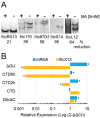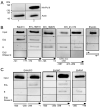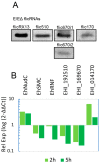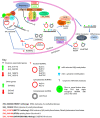Promoter-Bound Full-Length Intronic Circular RNAs-RNA Polymerase II Complexes Regulate Gene Expression in the Human Parasite Entamoeba histolytica
- PMID: 35202086
- PMCID: PMC8876499
- DOI: 10.3390/ncrna8010012
Promoter-Bound Full-Length Intronic Circular RNAs-RNA Polymerase II Complexes Regulate Gene Expression in the Human Parasite Entamoeba histolytica
Abstract
Ubiquitous eukaryotic non-coding circular RNAs are involved in numerous co- and post-transcriptional regulatory mechanisms. Recently, we reported full-length intronic circular RNAs (flicRNAs) in Entamoeba histolytica, with 3'ss-5'ss ligation points and 5'ss GU-rich elements essential for their biogenesis and their suggested role in transcription regulation. Here, we explored how flicRNAs impact gene expression regulation. Using CLIP assays, followed by qRT-PCR, we identified that the RabX13 control flicRNA and virulence-associated flicRNAs were bound to the HA-tagged RNA Pol II C-terminus domain in E. histolytica transformants. The U2 snRNA was also present in such complexes, indicating that they belonged to transcription initiation/elongation complexes. Correspondingly, inhibition of the second step of splicing using boric acid reduced flicRNA formation and modified the expression of their parental genes and non-related genes. flicRNAs were also recovered from chromatin immunoprecipitation eluates, indicating that the flicRNA-Pol II complex was formed in the promoter of their cognate genes. Finally, two flicRNAs were found to be cytosolic, whose functions remain to be uncovered. Here, we provide novel evidence of the role of flicRNAs in gene expression regulation in cis, apparently in a widespread fashion, as an element bound to the RNA polymerase II transcription initiation complex, in E. histolytica.
Keywords: Pol II-CTD; circRNA; flicRNA; gene promoter; splicing; transcription regulation.
Conflict of interest statement
The authors declare no conflict of interest.
Figures





Similar articles
-
In Silico Identification and Characterization of circRNAs as Potential Virulence-Related miRNA/siRNA Sponges from Entamoeba histolytica and Encystment-Related circRNAs from Entamoeba invadens.Noncoding RNA. 2022 Sep 26;8(5):65. doi: 10.3390/ncrna8050065. Noncoding RNA. 2022. PMID: 36287117 Free PMC article.
-
Postsplicing-Derived Full-Length Intron Circles in the Protozoan Parasite Entamoeba histolytica.Front Cell Infect Microbiol. 2018 Aug 3;8:255. doi: 10.3389/fcimb.2018.00255. eCollection 2018. Front Cell Infect Microbiol. 2018. PMID: 30123775 Free PMC article.
-
Negative and positive mRNA splicing elements act competitively to regulate human immunodeficiency virus type 1 vif gene expression.J Virol. 2008 Apr;82(8):3921-31. doi: 10.1128/JVI.01558-07. Epub 2008 Feb 13. J Virol. 2008. PMID: 18272582 Free PMC article.
-
Expression of human snRNA genes from beginning to end.Biochem Soc Trans. 2008 Aug;36(Pt 4):590-4. doi: 10.1042/BST0360590. Biochem Soc Trans. 2008. PMID: 18631122 Review.
-
Recognition of the 5' splice site by the spliceosome.Acta Biochim Pol. 1998;45(4):869-81. Acta Biochim Pol. 1998. PMID: 10397335 Review.
Cited by
-
Multiple types of nuclear localization signals in Entamoeba histolytica.Biochem Biophys Rep. 2024 Jul 4;39:101770. doi: 10.1016/j.bbrep.2024.101770. eCollection 2024 Sep. Biochem Biophys Rep. 2024. PMID: 39055170 Free PMC article.
-
Circular RNAs: characteristics, functions, mechanisms, and potential applications in thyroid cancer.Clin Transl Oncol. 2024 Apr;26(4):808-824. doi: 10.1007/s12094-023-03324-0. Epub 2023 Oct 21. Clin Transl Oncol. 2024. PMID: 37864677 Review.
-
Circular RNAs in coronary heart disease: From molecular mechanism to promising clinical application (Review).Int J Mol Med. 2025 Jan;55(1):11. doi: 10.3892/ijmm.2024.5452. Epub 2024 Nov 8. Int J Mol Med. 2025. PMID: 39513584 Free PMC article. Review.
-
In Silico Identification and Characterization of circRNAs as Potential Virulence-Related miRNA/siRNA Sponges from Entamoeba histolytica and Encystment-Related circRNAs from Entamoeba invadens.Noncoding RNA. 2022 Sep 26;8(5):65. doi: 10.3390/ncrna8050065. Noncoding RNA. 2022. PMID: 36287117 Free PMC article.
References
Grants and funding
LinkOut - more resources
Full Text Sources

